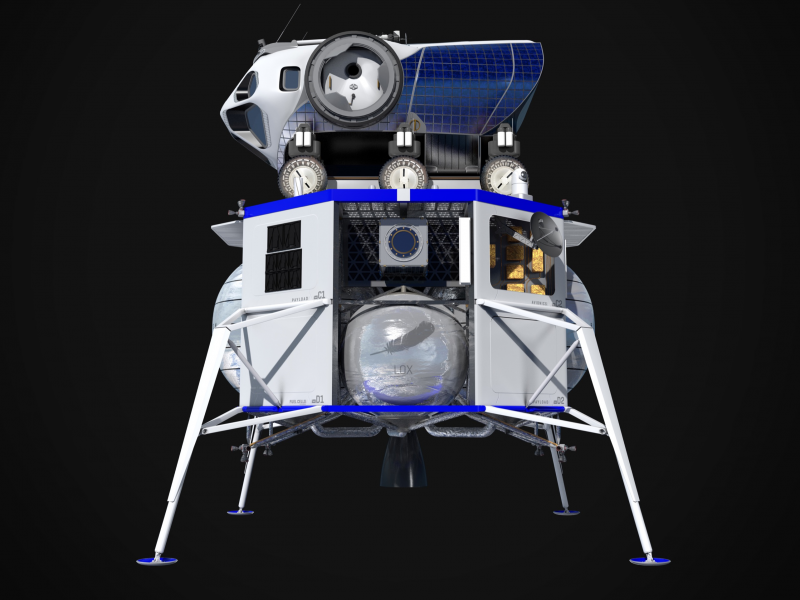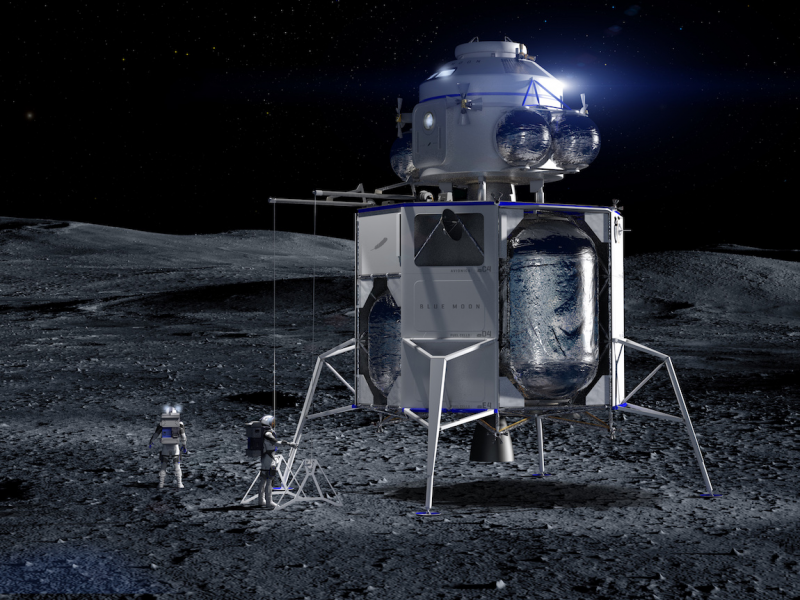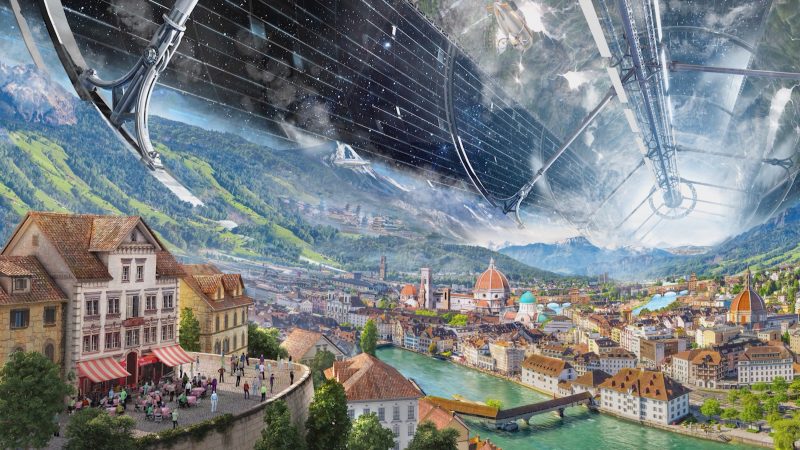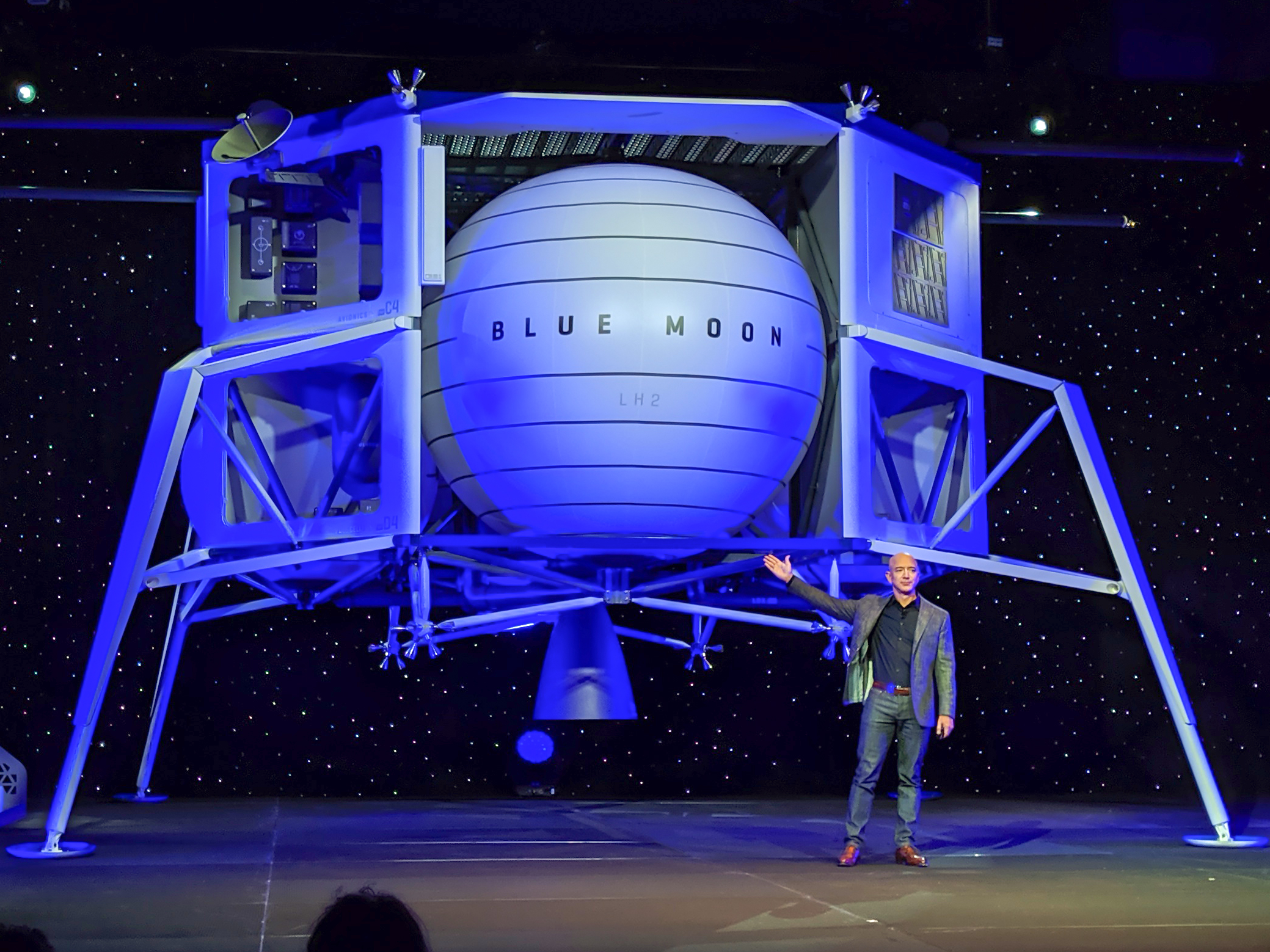- Jeff Bezos, the billionaire founder of Amazon, unveiled on Thursday a giant lunar lander concept by his spaceflight company, Blue Origin.
- Called “Blue Moon,” the vehicle is designed to deliver a variety of types of payloads to the moon’s surface – including people at some point.
- NASA said in April that it wants to fund a large, private lunar lander to get its astronauts to and from the moon, ideally as soon as 2024.
- Visit Business Insider’s homepage for more stories.
WASHINGTON, DC – Jeff Bezos unveiled a giant lunar-landing vehicle created by his rocket company Blue Origin.
Called “Blue Moon,” the lander is designed to deliver a variety of sizes and types of payloads to the moon’s surface, with the eventual goal of establishing what the company calls a “sustained human presence” on the moon.
“This is an incredible vehicle, and it’s going to the moon,” Bezos said at an event in Washington, DC, on Thursday afternoon.
Blue Origin had been teasing the idea of a lunar lander called Blue Moon over the past few years, and the company recently received millions of dollars in grants from NASA to develop critical lunar-lander systems. But until today hadn’t yet spoken in detail about concrete plans or hardware.

The life-size model of the Blue Moon lander that Bezos revealed on Thursday is a descent stage designed to carry robotic and infrastructure payloads to the moon weighing up to 4 tons (3.6 metric tonnes). It has a flat top where all sorts of payloads can be attached - one rendering that Bezos presented showed a lunar rover on top. The lander will also use LIDAR to self-land within 75 feet of where it's supposed to go, and has tall landing legs to tower over even large boulders.
Conveniently, the dimensions of Blue Moon appear to be just under 23 feet (7 meters). This is the maximum size that Blue Origin's upcoming and partly reusable rocket system, called New Glenn, could accommodate inside its nosecone.
Bezos also unveiled a stout yet flexible new rocket engine, called BE-7, that he said will enable Blue Moon to exist. The engine will burn hydrogen with oxygen, which are the two ingredients of water and can be made from ice deposits on the moon.
"We're using liquid hydrogen because, ultimately, we're going to be able to get hydrogen from that water on the moon and be able to refuel these vehicles on the surface," Bezos said.
A moon-size advertisement for NASA

No spacecraft able to carry people was presented, though, and multiple Blue Origin officials at the event declined to comment on the company's plans for making one or collaborating on one with other companies.
However, Bezos noted payloads on an upcoming version could weigh up to 7 tons (6.5 metric tonnes) and, according to the company's website, "the larger variant of Blue Moon has been designed to land an ascent vehicle that will allow us to return Americans to the moon by 2024."
With this new announcement, Bezos is angling for NASA's attention. The space agency recently updated its space-exploration plans at the behest of Vice President Mike Pence and President Donald Trump. NASA originally hoped to test a moon lander in 2024, then try for crewed landings in 2028; but now the agency is attempting to attract private industry to design and build a spacecraft to land astronauts on the moon in 2024.
"We can help meet that timeline, but only because we started three years ago," Bezos said. "It's time to go back to the moon, and this time to stay." (Blue Origin officials declined to provide an estimate of cost to NASA for developing and building Blue Moon landers.)
Bezos appears set on reaching a site on the moon's South Pole called Shackleton Crater, an idea that Blue Origin teased ahead of the event on Thursday. At Shackleton, water ice likely exists - and abundantly so - in permanently shadowed areas, and possibly just underneath a layer of lunar soil, too.
A trillion people living and working in space?

The unveiling of Blue Moon capped off a talk that Bezos often gives regarding the future of humanity. The way he sees it, the solar system could support a trillion people living and working in space, primarily inside enormous O'Neill space colonies that simulate conditions on our planet.
Bezos sees the New Glenn rocket as creating an affordable road to space, and Blue Moon as a way to establish a permanent presence on another world. He hopes future generations will use both to unleash their creativity like so many young entrepreneurs do today with infrastructure that's often taken for granted.
The goal: Move heavy industry and energy generation off-Earth to return the planet to a more pristine condition and treat as a residential haven.
"Please make no mistake about this: Earth is the best planet. It isn't close. We do need to protect it, it's essential, it's our job. We're now big enough to hurt this planet. We have to use the resources of space," he said. "We must have a future for our grandchildren and their grandchildren of dynamism - we cannot let them fall prey to stasis and rationing."
Some of Bezos' presentation was critical, though indirectly, of Elon Musk and SpaceX's plans to populate Mars. Bezos argued the red planet is too far away to foster human progress, among other problems.
When a Twitter user asked Musk if he'd ever collaborate with Blue Origin, he said: "Competition is good. Results in a better outcome for all."
However, Musk couldn't resist working in a humorous dig at his rival.
"But putting the word 'Blue on a ball is questionable branding," Musk added.
